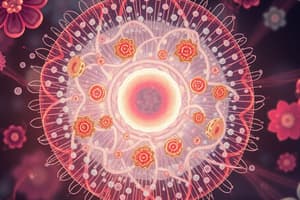Podcast
Questions and Answers
True or false: Las células eucariotas carecen de una membrana nuclear.
True or false: Las células eucariotas carecen de una membrana nuclear.
False (B)
True or false: Las mitocondrias tienen su propio ADN.
True or false: Las mitocondrias tienen su propio ADN.
True (A)
True or false: Los glaucófitos tienen cianelas.
True or false: Los glaucófitos tienen cianelas.
True (A)
Flashcards are hidden until you start studying
Study Notes
-
Eukaryotic cells are typically much larger than prokaryotic cells and have a variety of internal membrane-bound structures.
-
The nucleus is surrounded by a double membrane known as the nuclear envelope, with nuclear pores that allow material to move in and out.
-
Various tube- and sheet-like extensions of the nuclear membrane form the endoplasmic reticulum, which is involved in protein transport and maturation.
-
In most eukaryotes, these protein-carrying vesicles are released through exocytosis.
-
The endoplasmic reticulum includes the rough endoplasmic reticulum where ribosomes are attached to synthesize proteins, which enter the interior space or lumen.
-
Subsequently, they generally enter vesicles, which bud off from the smooth endoplasmic reticulum.
-
Mitochondria provide energy to the eukaryote cell by oxidising sugars or fats and releasing energy as ATP.
-
Mitochondria have two surrounding membranes, each a phospholipid bi-layer; the inner of which is folded into invaginations called cristae where aerobic respiration takes place.
-
The outer mitochondrial membrane is freely permeable and allows almost anything to enter into the intermembrane space while the inner mitochondrial membrane is semi permeable so allows only some required things into the mitochondrial matrix.
-
Mitochondria contain their own DNA, which has close structural similarities to bacterial DNA, and which encodes rRNA and tRNA genes that produce RNA which is closer in structure to bacterial RNA than to eukaryote RNA.
-
They are now generally held to have developed from endosymbiotic prokaryotes, probably Alphaproteobacteria.
-
Some eukaryotes, such as the metamonads such as Giardia and Trichomonas, and the amoebozoan Pelomyxa, appear to lack mitochondria, but all have been found to contain mitochondrion-derived organelles, such as hydrogenosomes and mitosomes, and thus have lost their mitochondria secondarily.
-
Plants and various groups of algae also have plastids. Plastids also have their own DNA and are developed from endosymbionts, in this case cyanobacteria.
-
Plastids usually take the form of chloroplasts which, like cyanobacteria, contain chlorophyll and produce organic compounds (such as glucose) through photosynthesis.
-
Others are involved in storing food. Although plastids probably had a single origin, not all plastid-containing groups are closely related. Instead, some eukaryotes have obtained them from others through secondary endosymbiosis or ingestion.
-
The capture and sequestering of photosynthetic cells and chloroplasts occurs in many types of modern eukaryotic organisms and is known as kleptoplasty.
-
Endosymbiotic origins have also been proposed for the nucleus, and for eukaryotic flagella.
-
Eukaryotic cells lack a cell wall and chloroplasts and have smaller vacuoles.
-
Animal cells can transform into a variety of shapes, and a phagocytic cell can even engulf other structures.
-
Plant cells have a number of features that distinguish them from the cells of the other eukaryotic organisms. These include: a cell wall made of cellulose, hemicellulose, and pectin, and a life cycle that involves sexual reproduction.
-
Fungal cells are similar to animal cells, with the exception that they have a fungal cell wall.
-
Other eukaryotic cells have unique organelles, such as the cyanelles (unusual plastids) of the glaucophytes, the haptonema of the haptophytes, or the ejectosomes of the cryptomonads.
-
Eukaryotes are a clade of organisms that include animals and plants.
-
Eukaryotes are distinguished from prokaryotes by their larger surface area to volume ratio and their multicellular phase.
-
Eukaryotes have a smaller metabolic rate and longer generation times than prokaryotes.
-
The evolution of sexual reproduction may be a primordial and fundamental characteristic of eukaryotes.
-
The eukaryotic kingdoms are Protista, Plantae, and Animalia.
-
Eukaryotes are divided into five supergroups according to their phylogenetic relationships.
-
There are smaller groups of eukaryotes whose position is uncertain or seems to fall outside the major groups.
Studying That Suits You
Use AI to generate personalized quizzes and flashcards to suit your learning preferences.




